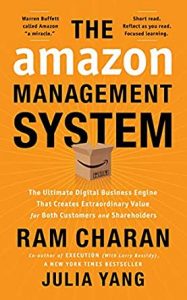
1. Unlike most business which is obsessed about competition, amazon is extremely obsessed with customers. Data is crucial and is the real equity for amazon. Data of customers is critical to identify customer needs, offer better service and value to them, which increases revenue output that further lowers cost and maximizes returns.
2. Raising the standards of talent is of utmost necessity. Leaders take ownership and never jeopardise the long-term mission for short-term results. Top management focus on:
- Hiring the best
- Practising frugality
- Delivering results
-The most successful are those who resilient to pressure, handle failure well and can carry on without being disrupted by such obstacles.
3. Focus on a powerful metric system
-All insights need to be backed by data and metrics.
-Tracking inputs is essential to ensure good outputs.
-Leaders function at every level, focusing on the details, regularly inspecting and reviewing metrics. A thorough system of metrics and data reduces the need for physical supervision and assistance.
4. Focus on inventions
-Organizations that innovate within their current capacity are destined to fail. You can’t achieve large-scale success unless you are ready to face the possibility of large-scale failure.
-The project team is accountable throughout the whole development. They have to take ownership right from concept to post-launch operation and everything in between.
5. System for high-quality decision making
The nature of decisions is ranked based on their level of impact they have in the organisation.
Type 1 decisions are consequential and irreversible.
Type 2 decisions refer to those that are alterable, reversible.
-Decisions should be made with around 70% of the information you wish you had. Waiting for more will slow down the process of decision-making.
-Amazon emphasizes fighting conformity, challenging group thinking.
# Key Takeaways:
– The Amazon Management System is based on 14 leadership principles that guide the company’s culture and decision-making processes.
– These principles include customer obsession, ownership, bias for action, and frugality, among others.
– The system also emphasizes the importance of data-driven decision making and continuous innovation.
– Amazon’s unique organizational structure, which is based on small, autonomous teams, is a key factor in its success.
– The company’s focus on long-term growth and willingness to take risks has allowed it to disrupt multiple industries.
# Practical Application:
– The principles outlined in The Amazon Management System can be applied in any organization, regardless of size or industry.
– Leaders can use these principles to create a customer-centric culture, foster innovation, and drive growth.
– The concept of small, autonomous teams can be implemented to improve decision-making and increase agility.
– Data-driven decision making can help organizations make more informed and effective choices.
– The system also emphasizes the importance of continuous learning and improvement, which can be applied in any real-world scenario.
# Valuable Insights for Leaders:
– The chapter on Amazon’s leadership principles offers valuable insights for individuals in leadership or management roles.
– The section on Amazon’s unique organizational structure can provide valuable lessons for leaders looking to improve their team dynamics.
– The chapter on data-driven decision making can help leaders understand the importance of using data to drive business decisions.
– The section on Amazon’s approach to risk-taking and long-term growth can offer valuable insights for leaders looking to drive innovation and disrupt their industries.
# Case Studies and Examples:
– The Amazon Management System is filled with case studies and examples that effectively illustrate its principles.
– The chapter on customer obsession includes examples of how Amazon has used customer feedback to improve its products and services.
– The section on ownership features case studies of how Amazon employees have taken ownership of projects and driven successful outcomes.
– The chapter on innovation includes examples of how Amazon has continuously innovated and disrupted multiple industries.
– The book also includes examples of how Amazon has used data to make strategic decisions and drive growth.
Leave a Reply